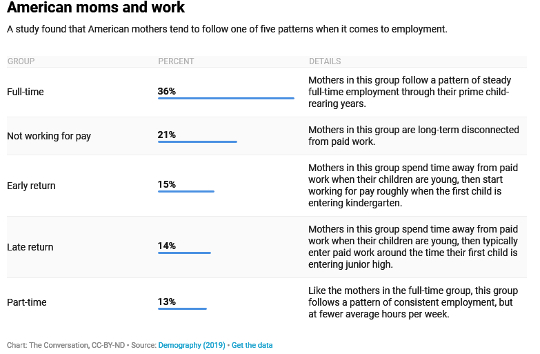 Many American mothers say part-time work would be ideal. Halfpoint/shutterstock.com
Many American mothers say part-time work would be ideal. Halfpoint/shutterstock.com
Almost 70% of American mothers with children under 18 work for pay.
But motherhood remains disruptive for many women’s work lives. American women earn almost 20% less per hour than their male peers, in part because women disproportionately take responsibility for raising children. Mothers often experience employment interruptions or reductions in work hours.
When it comes to understanding mothers’ long-term employment patterns, researchers know less. How common is it for mothers to persist working full-time throughout their child-rearing years? Which mothers are most likely to be absent from the labor market over the long term? What do employment patterns look like for mothers who fall in between these two extremes?
In a study published in February, we set out to answer such questions. Our research shows that American mothers combine work and family in diverse ways, depending upon their preferences for work, their ability to maintain employment and their need to provide financially for their families.
What employment patterns do mothers follow?
Using national survey data, we looked at common employment patterns for over 3,000 American mothers currently in their mid-50s to early 60s. For these older women, we examined their prime child-rearing years, from the birth of their first child to when that child turned 18.
Motherhood frequently disrupts employment. A year before the birth of their first child, about half of the women in our sample were employed full-time. By the time of the birth, only 20% were. Disruptions are not limited to new mothers: It takes over a decade for mothers’ full-time employment rate to return to 50%.
Using statistical methods, we identified five common patterns of maternal employment over the first 18 years after a first birth. At one extreme, nearly two-fifths of mothers followed a pattern of steady full-time employment. At the other extreme, one-fifth of mothers were almost completely disconnected from employment.
The remaining three groups of mothers – each about 15% of our sample – cannot be easily classified as long-term “career moms” or “stay-at-home moms.”
Two groups spend time out of the labor market while their children are young, then enter employment and ultimately start working full-time. They differ in their typical timing of transition to paid work. One group begins roughly when the first child is entering kindergarten, while the other doesn’t enter full-time work until approximately when the first child is entering junior high.
The last group follows a pattern of consistent part-time work. Like the mothers in the full-time group, they work consistently, but at fewer average hours per week.

Which mothers follow which work patterns?
Let’s look at characteristics of moms who are long-term full-time employed, part-time employed or out of the labor force.
Mothers who consistently work full-time tend to be those who need to. They are less likely to be married, and those who are married have husbands with lower average wages.
Mothers in this group also have resources that support their employment, specifically personal and family histories of employment. Compared to mothers in other groups, they worked more prior to becoming a mother and were more likely to grow up with a working mother. African American mothers are more likely than white mothers to consistently work full-time.
By contrast, mothers who don’t work for pay for most of their child-rearing years also worked less than other women before becoming mothers. For some women in this group, spending time out of the labor market either before or after having children may be a choice – on average, the mothers in this group have less egalitarian attitudes toward women’s roles than mothers in other groups. For other women, the challenges of finding and keeping a job may keep them out of the workforce; mothers in this group are also most likely to lack a high school degree.
Like the full-time group, the part-time working mothers were likely to have resources, like education and pre-maternity work experience, that supported their employment. What then, distinguishes this group from those who work full-time? Compared to the full-time group, they have fewer financial pressures to work for pay. Mothers with long-term part-time employment are on average relatively socially and economically advantaged. They tend to be married, white and older when they have their first child. They are not particularly traditional and even stand out for their low levels of religious attendance.
Do mothers get the type of employment they want?
American mothers balance employment and motherhood in many ways. In part, this reflects different preferences. But not all mothers can pursue their preferred employment pattern.
When mothers were asked what their “ideal” work situation would be in a 2012 Pew Research Center survey, the most common response was part-time work. Yet long-term part-time work is relatively uncommon for American mothers – only about 15% fall into this group.
Although it’s the most common preference, long-term part-time work is the reality only for a relatively advantaged minority. This shows that unequal experiences of motherhood and employment among American mothers reflect not only different preferences, but different financial pressures to work and unequal opportunities to secure employment.![]()
About The Author
Alexandra Killewald, Professor of Sociology, Harvard University and Xiaolin Zhuo, Doctoral Student in Sociology, Harvard University
This article is republished from The Conversation under a Creative Commons license. Read the original article.
Related Books
at InnerSelf Market and Amazon


























